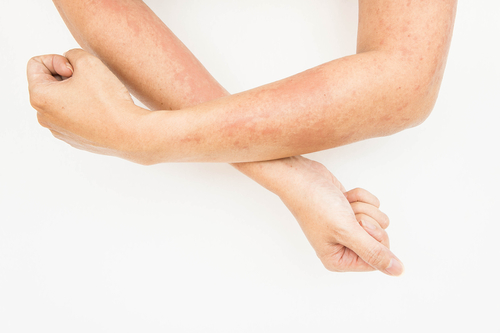Skin Fibrosis Scores Can Be Surrogate Marker for dcSSc Severity, Study Finds

Progressive skin fibrosis within one year increases the risk of lung function decline and mortality in patients with diffuse cutaneous systemic scleroderma (dcSSc), a large-scale observational study found.
The finding suggests that skin fibrosis scoring can work as a potential surrogate marker for dcSSc severity in clinical trials and routine assessments.
The study, “Progressive skin fibrosis is associated with a decline in lung function and worse survival in patients with diffuse cutaneous systemic sclerosis in the European Scleroderma Trials and Research (EUSTAR) cohort,” was published in the journal Annals of the Rheumatic Diseases.
Systemic scleroderma (SSc) is a heterogeneous disease that may cause scarring of internal organs; this is linked to a worsened patient prognosis. With increased numbers of disease-modifying therapies undergoing late-phase developments, clinicians need accurate approaches to identify at-risk patients who require early intervention.
Skin fibrosis (a hallmark of SSc) is often assessed using the modified Rodnan skin score (mRSS), which evaluates skin thickness from 0 (normal) to 3 (severe) on 17 body points (maximum score of 51). Although reports suggest mRSS as a surrogate marker for SSc severity and mortality, the studies are older or selective (from smaller clinical trials).
To further test this, researchers used data from the large-scale observational study European Scleroderma Trials and Research (EUSTAR) to investigate the link between skin fibrosis and disease duration, progression, or mortality in patients with dcSSc.
The study included data from 1,021 dcSSc patients (mean age 52) with diffuse cutaneous involvement, at least one annual follow-up (median follow-up 3.4 years), and an mRSS score at or above 7, which is the minimal dsSSc-characterizing value. Patients had a mean disease duration of 7.7 years, and a mean baseline mRSS score of 16.9.
Researchers defined skin fibrosis progression as an increase in mRSS of more than five units, and 25% or more change from baseline, a definition commonly used in clinical trials to identify skin progression. Of the included participants, 78 (7.6%) had skin fibrosis progression at one-year follow-up (referred to as skin progressors).
Among dcSSc participants with available computed tomography (CT) data (670 patients), 60.1% had lung fibrosis at baseline.
The team found that about one in five participants (20.8%) had a forced vital capacity (FVC; a measurement of lung function) below 70 percent at baseline (cohort mean, 86.9%).
Overall, there were 30 (53.6%) and 252 (34.4%) events in the skin progressor and non-progressor groups, respectively, suggesting that the likelihood of FVC decline was higher among skin progressors.
To evaluate lung disease progression, researchers analyzed FVC alone or in combination with patients’ diffusing capacity for carbon monoxide (DLCO; tests gas transfer between the lungs and blood).
The conventional definition establishes lung disease progression upon at least a 10 percent decrease in FVC from baseline. The FVC-DLCO composite definition is an exploratory approach determining progression as FVC decreasing at least 10 percent from baseline, or 5-9 percent if combined with a decrease in DLCO of at least 15 percent.
Both definitions yielded similar results, showing significant decreases in FVC and FVC-DLCO composite in the skin progressor group compared with non-progressor.
Also, lung progression assessments in a subgroup of patients with low mRSS at baseline (mRSS at or less than 22), showed that skin progressors had a significantly higher probability of decreased lung function, according to both definitions.
Results also showed that in patients with short disease duration (15 months or less), skin progressors had a higher probability of experiencing FVC or FVC-DLCO decline, compared with non-progressors. These differences were not observed in patients with longer disease-durations (15 months or more).
The team next compared all-cause mortality (7.9% deaths during median follow-up) and disease progression, and found a significant increase in both parameters among skin progressors (15.4% and 74%, respectively) compared with non-progressors (7.3% and 55.4%, respectively).
Also, in subgroups of patients with low baseline mRSS and short disease duration, skin progressors had a significantly higher probability of all-cause death compared with non-progressors.
“Our findings indicate that patients with dcSSc and skin progression within one year have a higher probability of lung [disease] progression and worse survival during follow-up,” researchers stated.
Based on these results, the team further suggested that mRSS progression within one year could be used as a surrogate marker for disease severity during follow-up.
“The evidence-based findings obtained from the large prospective EUSTAR cohort allow optimization of cohort enrichment in future clinical trials aimed at skin and lung fibrosis, and also help clinicians to identify patients at risk of lung progression in clinical practice,” the researchers concluded.






